
Virginia University of Lynchburg (VUL) is a private historically black Christian university in Lynchburg, Virginia. The university is accredited by the Transnational Association of Christian Colleges and Schools and offers instruction and degrees, primarily in religious studies, including a Doctorate of Ministry program. The campus is a historic district listed on the National Register of Historic Places.
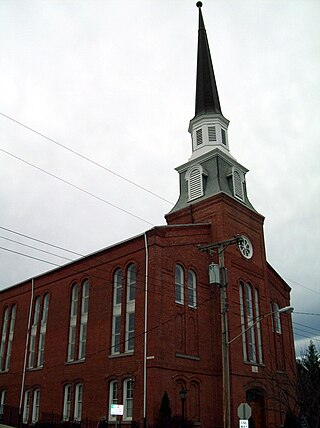
The tallest object on the downtown skyline of Lynchburg, Virginia, Court Street Baptist Church stands as a testament to the black Baptist population of Lynchburg. Organized in 1843, the congregation—originally known as the African Baptist Church of Lynchburg—was the first of its kind in the city. The church was designed by R.C. Burkholder, and completed in 1880.
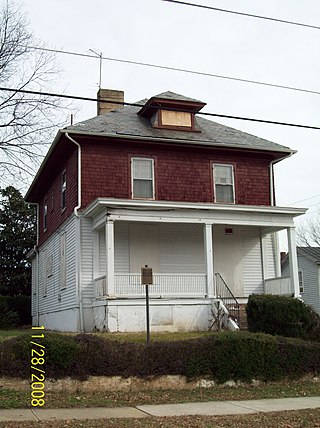
Dr. Robert Walter Johnson House and Tennis Court is a historic home and tennis court in Lynchburg, Virginia, U.S., that was built in 1911 and added to the National Register of Historic Places in 2002. It is located in the Pierce Street Historic District.

The Academy of Music is a historic theatre building located in Lynchburg, Virginia. The three story theater was built 1904–05 in the Beaux Arts style with a Neoclassical interior. It was designed by Frye & Chesterman. It is one of the only surviving legitimate theaters of the turn-of-the-century period in Virginia. Some of the more notable European and American names to appear on its stage included Ignace Paderewski, Anna Pavlova, Sarah Bernhardt, Alma Gluck, DeWolf Hopper, Otis Skinner, John Drew and Mrs. Patrick Campbell. In 2008, the Lynchburg Academy of Fine Arts received a $245,000 earmark from Representative Bob Goodlatte from the Community Development Fund of the United States Department of Housing and Urban Development, for renovations to the building.

The Aviary is a historic aviary building located in Miller Park at Lynchburg, Virginia. It is a Queen Anne-style structure erected in 1902. The multi-sided exhibition house was designed by the local architectural firm of Frye & Chesterman. The building was a gift to the city of Lynchburg from Randolph Guggenheimer of New York City. When completed, the Aviary housed, "Seven cages containing monkeys, one with at least a half dozen healthy alligators, one with cockatoos, one with Australian doves, one with parrots and one with canaries." It later became a branch library and an office structure for the city Department of Parks and Recreation.

Jones Memorial Library is a specialized genealogy and history research library located at 2311 Memorial Avenue in Lynchburg, Virginia.
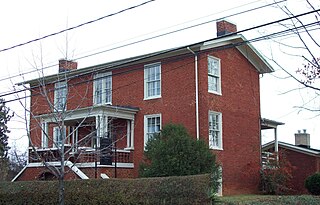
Centerview is a historic home located at Lynchburg, Virginia. It is a two-story brick house completed in 1871 in the Greek Revival style. The dependency, which is similar in construction and detail to the main house but which may date to 1861, is a one-stay gabled brick building and originally served as a summer kitchen and cook's dwelling among other functions. The house and dependency were rehabilitated in 1999–2000 as law offices. Robert Withers Morgan and his family were long resident in the house; one of his six children was the painter Georgia Weston Morgan, who resided there until 1923.

Miller–Claytor House is a historic home located at Riverside Park in Lynchburg, Virginia. It is a two-story, white framed structure, sheathed with beaded weatherboards. It is believed to be the fourth house erected in the new town in 1791, and is probably the oldest extant Lynchburg dwelling. In 1936, the imminent demolition of the house led to the formation of the Lynchburg Historical Society and the subsequent removal of the house to its present site.

Historic Sandusky is a historic home located in Lynchburg, Virginia. It is a formal two-story, brick "I" house built about 1808, with a later addition. It was built by Charles Johnston, and is one of the earliest homes in the Lynchburg area to display the architectural details and refinements characteristic of Federal design.

John Marshall Warwick House is a historic home located at Lynchburg, Virginia. It was built in 1826 by prominent Lynchburg tobacconist and city mayor (1833), John Marshall Warwick. It was one of the first houses to be built on the crest of Lynchburg Hill, later to be called Court House Hill, overlooking the James River. It exhibits the transition from the Federal to the Greek Revival styles. His grandson, United States Senator John Warwick Daniel was born in this home.

Rosedale, a historic property comprising the Graves Mill ruins, Christopher Johnson Cottage, and Rosedale mansion, is located at Lynchburg, Virginia. The Rosedale property contains two buildings of major importance, the ruins of an 18th-century grist mill, and numerous subsidiary buildings. The earliest structure remaining is the Christopher Johnson Cottage, dating from ca. 1764 to 1774. The small, 1+1⁄2-story frame structure has long been known as the Johnson Cottage. The Rosedale mansion was erected in 1836 by Odin Clay, the first president of the Virginia and Tennessee Railroad, and is a two-story, three-bay, brick home laid in Flemish bond. The house was enlarged in 1929; a three-bay brick wing was added the original house. It was designed by Lynchburg architect Stanhope S. Johnson, who is best known for designing the Allied Arts Building.

First Baptist Church is a historic Baptist church located at 1100 Court Street, Lynchburg, Virginia. It is built of hard-pressed red brick on a rough granite foundation. The main facade of the church, facing Eleventh Street, and the two sides are centered with large rose windows framed within Gothic arches covered with hood moldings. Construction began in 1884 and the church was dedicated in 1886. In the 1920s, Lynchburg architect Stanhope S. Johnson designed the complementary Sunday School annex. In 1941, the interior of the sanctuary was modified by Stanhope S. Johnson, with the creation of a divided chancel. It is home to the oldest Baptist congregation of Lynchburg, established in July 1815. Current as of 2020, First Baptist Church is affiliated with the Cooperative Baptist Fellowship (CBF).

St. Paul's Church is a historic Episcopal church in Lynchburg, Virginia, United States.

The South River Friends Meetinghouse, or Quaker Meeting House, is a historic Friends meeting house located at Lynchburg, Virginia. It was completed in 1798. It is a rubble stone structure, approximately 30 by 51 feet, with walls 16 inches thick, and 12 feet high. The building ceased as a Quaker meeting house in the 1840s and stands on the grounds of the Quaker Memorial Presbyterian Church. Adjacent to the structure is a historic graveyard. Buried there are Sarah Lynch and her son John, the founder of the city whose final resting place is marked by a plain Quaker stone and a modern plaque.
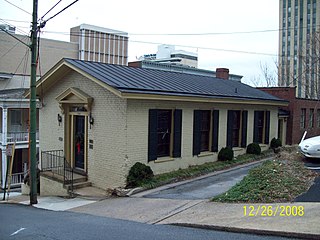
The Saint Paul's Vestry House is a historic building in Lynchburg, Virginia, United States. It was built about 1855 and is a single-story Classical Revival-style building with a simple low pitched gable roof and a rectangular plan. It is likely the only vestry house built exclusively for the governing body of an Episcopal Church in Virginia. It also served as the first home of the Lynchburg Woman's Club from 1903 to 1916.

The Lynchburg Courthouse is a historic courthouse building located at Lynchburg, Virginia. Built in 1855, it occupies a prominent position overlooking the steeply descending steps of Monument Terrace. The building is executed in stucco-over-brick on a granite ashlar basement and is an example of the Greek Revival. The building is capped by a shallow dome located over the intersection of the ridges. At the top of the dome is a small open belfry consisting of a circle of small Ionic columns supporting a hemispherical dome. The front of the court house has a three-bay Doric portico.
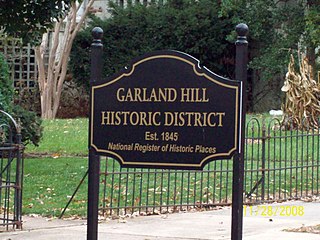
The Garland Hill Historic District is a national historic district located in Lynchburg, Virginia. The area is a small residential neighborhood incorporating the summit of one of the numerous hills surround downtown Lynchburg. The neighborhood was home to many of Lynchburg's oldest and most distinguished families, many of whom were associated with the tobacco industry. Buildings in the district represent a variety of styles from the early 19th century through the early 20th century including the Gothic Revival, Victorian, and Queen Anne styles, some of which were designed by Lynchburg architects Edward Frye and Stanhope S. Johnson.

The Rivermont Historic District is a national historic district located in Lynchburg, Virginia. It is a 192.10-acre (0.7774 km2) district consisting of the 300-3400 blocks of Rivermont Avenue as well as Riverside Park and a few properties alongside streets that face onto Rivermont Avenue. It is bounded by the James River on the east and northeast, Blackwater Creek on the east and southeast, Daniel's Hill on the north and Virginia Episcopal Road and the southern end of Boonesboro Road.

Salem Veteran Affairs Medical Center(VAMC) is a VA hospital located in Salem, Virginia. Health care services are provided to veterans living in a 26-county area of southwestern Virginia. In addition to the main facility in Salem, there are affiliated services in three community-based outpatient clinics. These clinics are located in Danville, Virginia, Lynchburg, Virginia, Tazewell, Virginia, Wytheville, Virginia, and Staunton, Virginia.
Pleasant Grove, also known as Joseph Deyerle House, Deyerle Homeplace, and Glenvar is a historic home located near Salem in Roanoke County, Virginia. It was built in 1853, and is a two-story, three-bay, Greek Revival style brick dwelling. The front facade features a well-proportioned Ionic order portico with slender tapered, fluted columns. It also has an original sunroom measuring 7 feet by 14 feet. Also on the property are the contributing kitchen, spring house, smokehouse, servant's house, and privy.





















